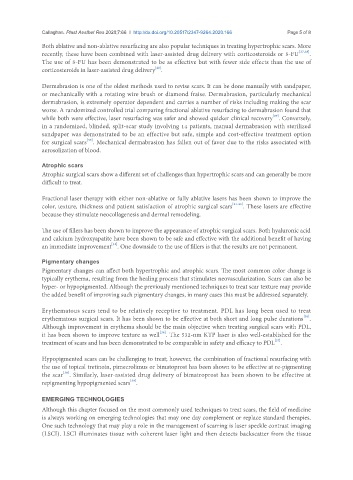Page 783 - Read Online
P. 783
Callaghan. Plast Aesthet Res 2020;7:66 I http://dx.doi.org/10.20517/2347-9264.2020.166 Page 5 of 8
Both ablative and non-ablative resurfacing are also popular techniques in treating hypertrophic scars. More
recently, these have been combined with laser-assisted drug delivery with corticosteroids or 5-FU [27,28] .
The use of 5-FU has been demonstrated to be as effective but with fewer side effects than the use of
[28]
corticosteroids in laser-assisted drug delivery .
Dermabrasion is one of the oldest methods used to revise scars. It can be done manually with sandpaper,
or mechanically with a rotating wire brush or diamond fraise. Dermabrasion, particularly mechanical
dermabrasion, is extremely operator dependent and carries a number of risks including making the scar
worse. A randomized controlled trial comparing fractional ablative resurfacing to dermabrasion found that
[29]
while both were effective, laser resurfacing was safer and showed quicker clinical recovery . Conversely,
in a randomized, blinded, split-scar study involving 14 patients, manual dermabrasion with sterilized
sandpaper was demonstrated to be an effective but safe, simple and cost-effective treatment option
[30]
for surgical scars . Mechanical dermabrasion has fallen out of favor due to the risks associated with
aerosolization of blood.
Atrophic scars
Atrophic surgical scars show a different set of challenges than hypertrophic scars and can generally be more
difficult to treat.
Fractional laser therapy with either non-ablative or fully ablative lasers has been shown to improve the
color, texture, thickness and patient satisfaction of atrophic surgical scars [31-33] . These lasers are effective
because they stimulate neocollagenesis and dermal remodeling.
The use of fillers has been shown to improve the appearance of atrophic surgical scars. Both hyaluronic acid
and calcium hydroxyapatite have been shown to be safe and effective with the additional benefit of having
[34]
an immediate improvement . One downside to the use of fillers is that the results are not permanent.
Pigmentary changes
Pigmentary changes can affect both hypertrophic and atrophic scars. The most common color change is
typically erythema, resulting from the healing process that stimulates neovascularization. Scars can also be
hyper- or hypopigmented. Although the previously mentioned techniques to treat scar texture may provide
the added benefit of improving such pigmentary changes, in many cases this must be addressed separately.
Erythematous scars tend to be relatively receptive to treatment. PDL has long been used to treat
[35]
erythematous surgical scars. It has been shown to be effective at both short and long pulse durations .
Although improvement in erythema should be the main objective when treating surgical scars with PDL,
[36]
it has been shown to improve texture as well . The 532-nm KTP laser is also well-established for the
[37]
treatment of scars and has been demonstrated to be comparable in safety and efficacy to PDL .
Hypopigmented scars can be challenging to treat; however, the combination of fractional resurfacing with
the use of topical tretinoin, pimecrolimus or bimatoprost has been shown to be effective at re-pigmenting
the scar . Similarly, laser-assisted drug delivery of bimatroprost has been shown to be effective at
[38]
[39]
repigmenting hypopigmented scars .
EMERGING TECHNOLOGIES
Although this chapter focused on the most commonly used techniques to treat scars, the field of medicine
is always working on emerging technologies that may one day complement or replace standard therapies.
One such technology that may play a role in the management of scarring is laser speckle contrast imaging
(LSCI). LSCI illuminates tissue with coherent laser light and then detects backscatter from the tissue

